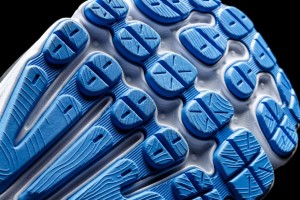 Traction: The SpeedForm Gemini features blown rubber throughout most of the outsole and in the heel, UA used carbon rubber on the contact point. The use of carbon rubber in this key area allows for a longer-lasting material, yet also provides excellent traction, which ideal for heel strikers. This shoe’s traction was exceptional on all surfaces in all different types of weather. The added bonus of having used the blown rubber on the outsole also provided an extra soft natural feel and added comfort when running on uneven surfaces.
Traction: The SpeedForm Gemini features blown rubber throughout most of the outsole and in the heel, UA used carbon rubber on the contact point. The use of carbon rubber in this key area allows for a longer-lasting material, yet also provides excellent traction, which ideal for heel strikers. This shoe’s traction was exceptional on all surfaces in all different types of weather. The added bonus of having used the blown rubber on the outsole also provided an extra soft natural feel and added comfort when running on uneven surfaces.
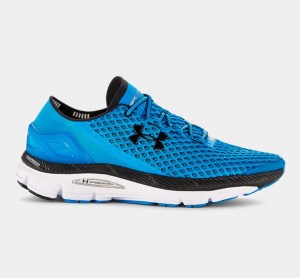 Cushion: This was the first running shoe from Under Armour to use their latest cushioning technology, Charged Foam. In the mid sole there is combined Micro G and UA’s new trademark Charged Foam, which results in superior cushioning and responsiveness. It gives you the best of both worlds, soft and cushy on impact and when running, you get the response and energy return to keep you going. Just like it’s predecessors in the SpeedForm line up, the Gemini also has a built in 4-D footbed that provides additional cushion and locks your foot in place by molding to the runner’s foot.
Cushion: This was the first running shoe from Under Armour to use their latest cushioning technology, Charged Foam. In the mid sole there is combined Micro G and UA’s new trademark Charged Foam, which results in superior cushioning and responsiveness. It gives you the best of both worlds, soft and cushy on impact and when running, you get the response and energy return to keep you going. Just like it’s predecessors in the SpeedForm line up, the Gemini also has a built in 4-D footbed that provides additional cushion and locks your foot in place by molding to the runner’s foot.
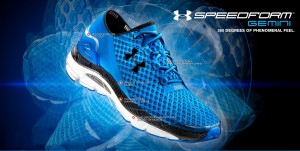 Materials: The SpeedForm Gemini is another model from UA that is following previous models and being designed at an UA apparel facility. The Gemini has the same close-to-foot feel that we have all become accustomed to when it comes to the SpeedForm models. I refer to it as a second skin; doesn’t quite feel like a sneaker but at the same time you know you have something on your foot. The upper is made up of primarily two materials. A synthetic precision-fit, almost like a light weight neoprene (used in the heel collar and upper tongue) and a perforated mesh with “no-seam” welding in order to reduce any friction points that might cause irritation during runs and there is also an external molded heel cup that helps secure your foot in place when laced up. The weight of the Gemini is 8.5 ounces for a men’s size 9.
Materials: The SpeedForm Gemini is another model from UA that is following previous models and being designed at an UA apparel facility. The Gemini has the same close-to-foot feel that we have all become accustomed to when it comes to the SpeedForm models. I refer to it as a second skin; doesn’t quite feel like a sneaker but at the same time you know you have something on your foot. The upper is made up of primarily two materials. A synthetic precision-fit, almost like a light weight neoprene (used in the heel collar and upper tongue) and a perforated mesh with “no-seam” welding in order to reduce any friction points that might cause irritation during runs and there is also an external molded heel cup that helps secure your foot in place when laced up. The weight of the Gemini is 8.5 ounces for a men’s size 9.
Fit: The SpeedForm Gemini fit is like having a sock on your foot. The SpeedForm material molds to your foot and the use of precision-fit synthetic material allows for your foot to move without feeling restricted. The Gemini has the same external molded heel cup in common with the other SpeedForm models but in my opinion, they perfected it with this model. In other SpeedForm models the heel cup was a softer, less supportive material where in the Gemini there is better support without being excessive.
Ventilation: What can I say? This shoe is COOL! It has tons of perforations in the mesh panels as well as the tongue. UA also used their signature moisture wicking technology to make sure that your foot stays cool and dry at all times.
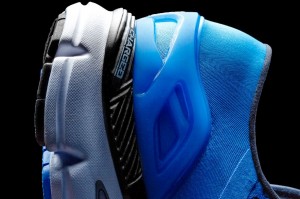 Support: While maintaining it’s neutral characteristics, the Gemini provides excellent cushioning and support from the use of the two foams, Charged Foam and Micro G. Although there are no added TPU bars or denser foams to provide added support for pronators, the external molded heel cup coupled with the the dual density foams just works perfectly together at keeping the runner’s foot balanced without favoring the lateral or medial side.
Support: While maintaining it’s neutral characteristics, the Gemini provides excellent cushioning and support from the use of the two foams, Charged Foam and Micro G. Although there are no added TPU bars or denser foams to provide added support for pronators, the external molded heel cup coupled with the the dual density foams just works perfectly together at keeping the runner’s foot balanced without favoring the lateral or medial side.
Overall: I am not trying to sound like a bias Under Armour fan, but I could not find anything wrong with this shoe at all. From the type and amount of rubber UA used on the outsole to the new Charged Foam, and Micro G cushion of the midsole all the way to the breathability the upper provided, this shoe was awesome. UA was able to provide more cushion than previous SpeedForm models and still keep the weight down to a lightweight runner by all standards in the running shoe market. I feel that with this model will appeal to runners who are looking for a shoe that has the feel and characteristics of your “traditional” running shoe. The only thing that I can say that if considering purchasing is you might want to go up half a size; they do run a little on the smaller side. I got an 11.5 and it fit perfectly and very similar to the SpeedForm Apollo, if that helps make it an easier.
The SpeedForm Gemini can be picked up today @ Under Armour for $129.99
Images via Under Armour

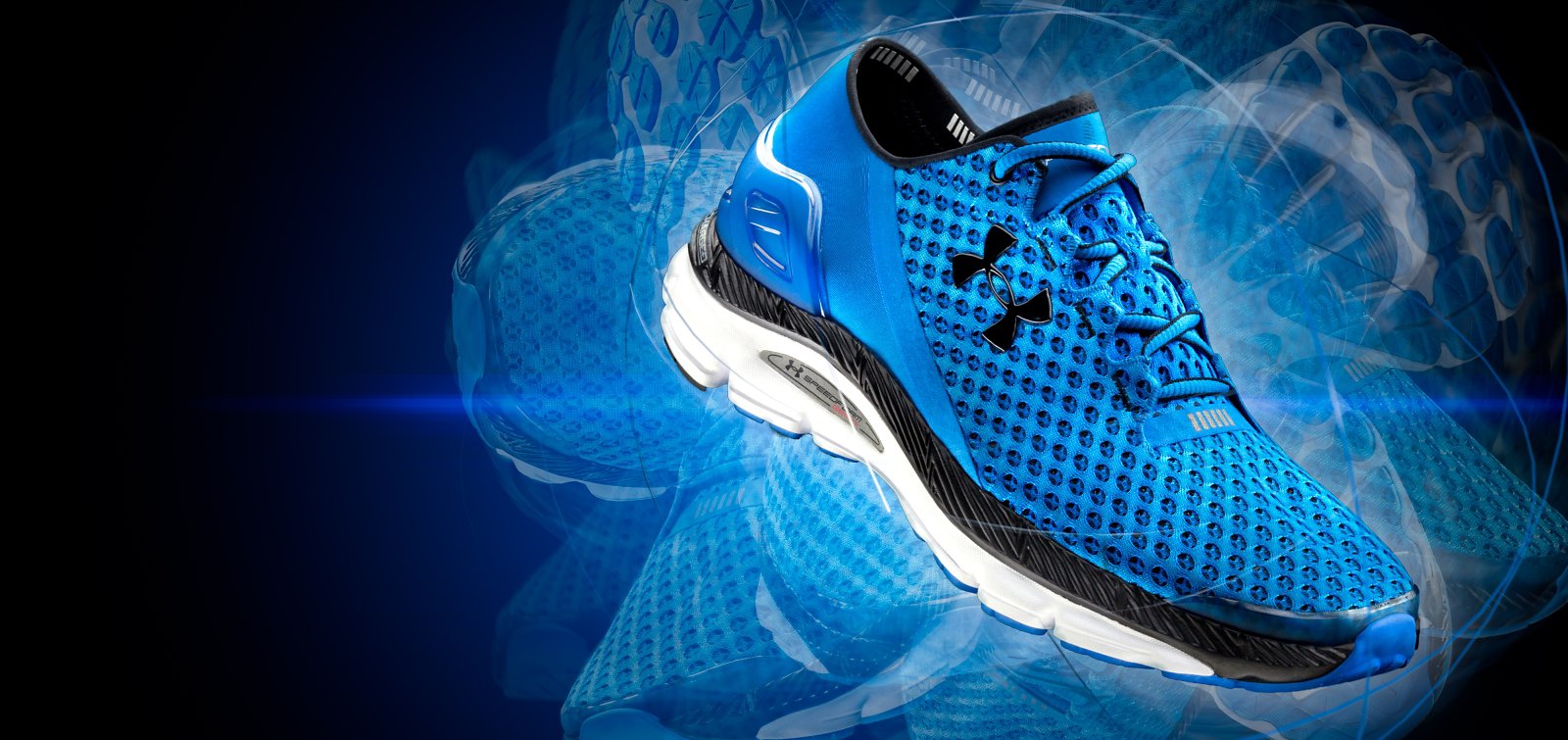
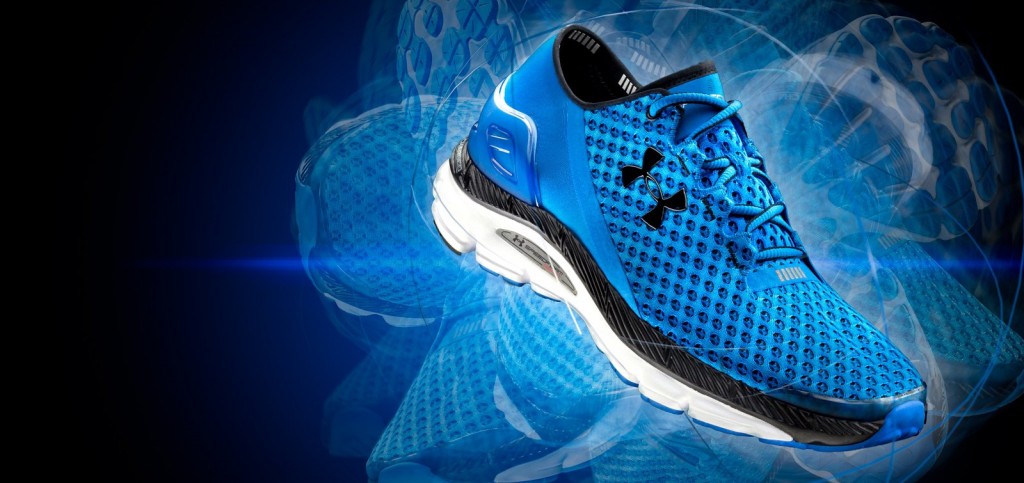
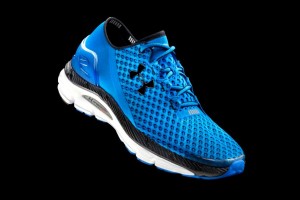
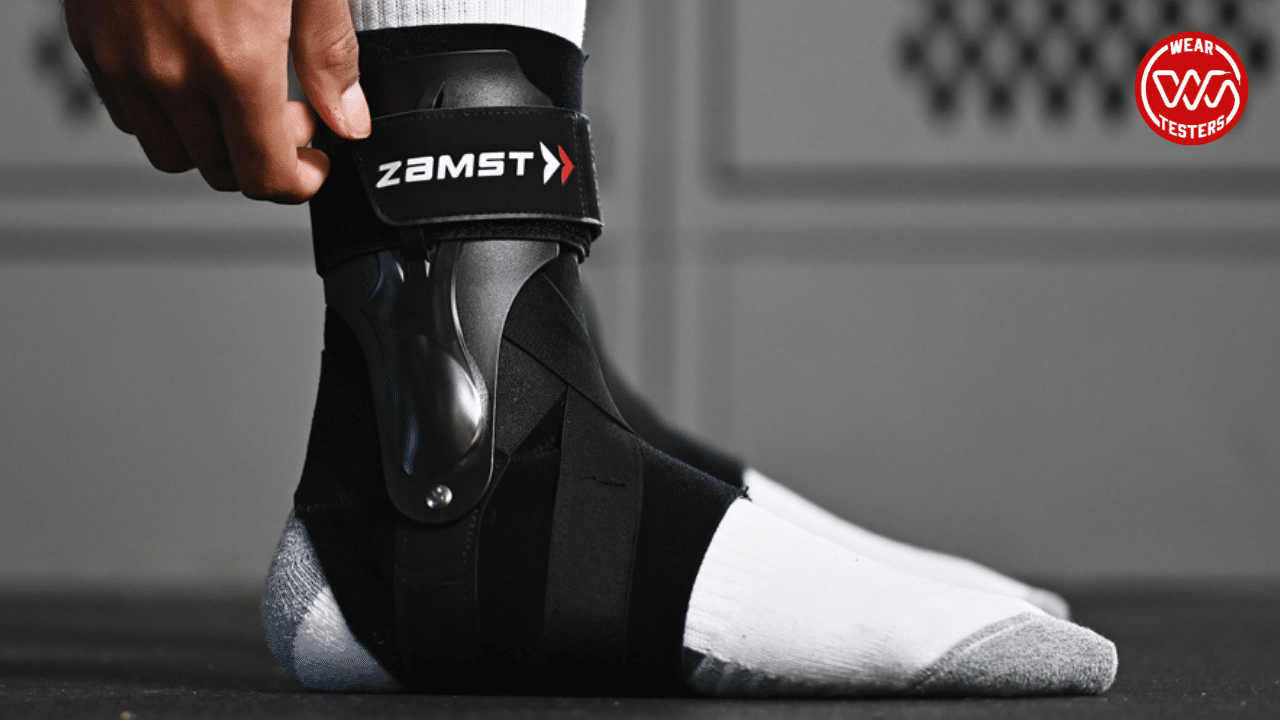
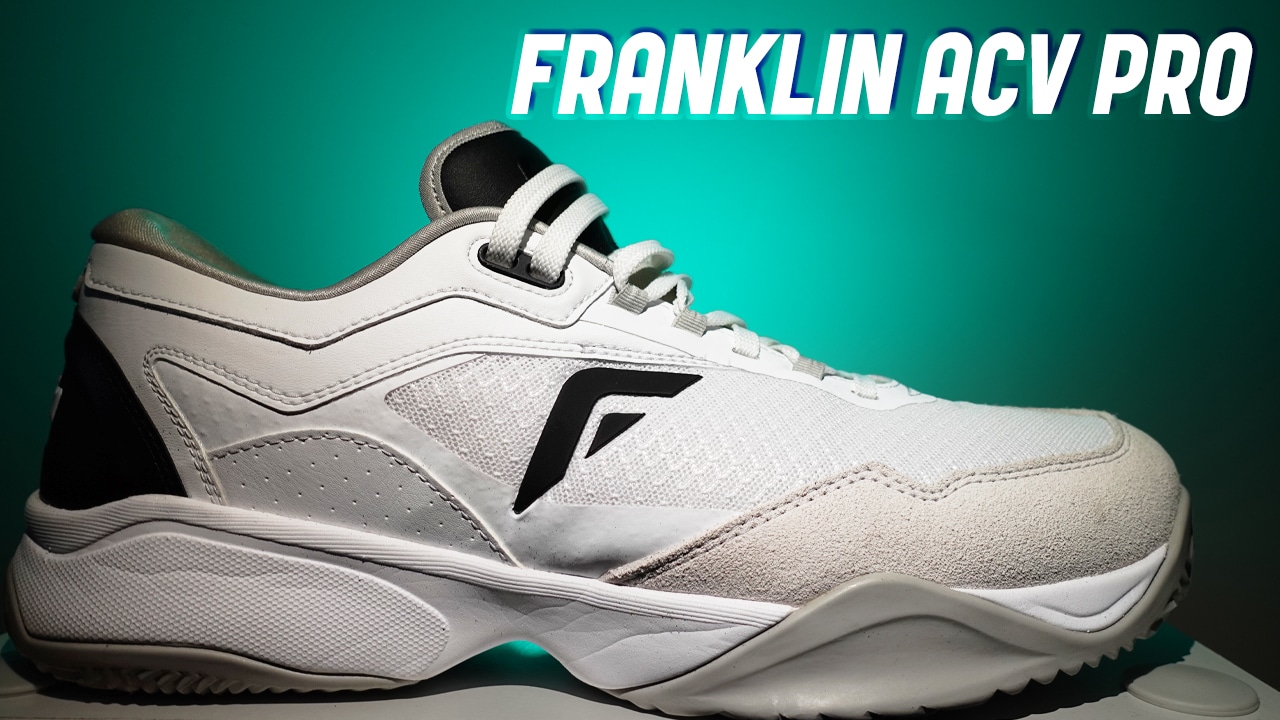
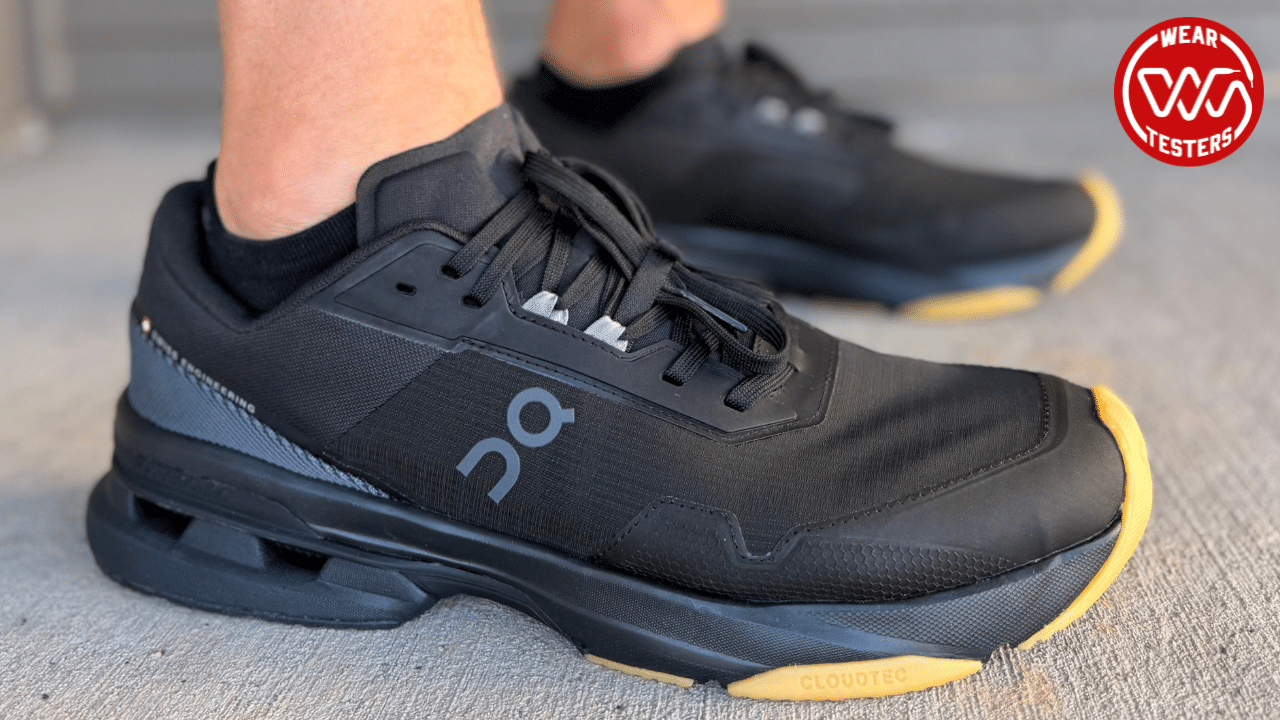
8mm drop — pass
An 8mm drop is actually a good offset for an everyday trainer. It’s not considered a minimalist shoe so I’m not sure why you are saying it’s bad.
^Hey man give them a break its the first shoe with charged cushioning. Thanks for the very detailed and informative review man I really appreciate it!! That being said, I do agree with Wuke, after trying out several 4mm and zero drop running shoes, going back to 8mm or more becomes a true hassle even if its a shoe I wear casually or in a training shoe. But that doesn’t mean this isn’t a great shoe just not meant for me and other forefoot strikers that can do long distance running in low or zero drop shoes. So I hope there is a zero drop shoe with Charged cushioning in the works.. And as a forefoot striker I feel the same with Basketball shoes, since I’m not a post player so a big heel drop makes it harder say on my toes and negatively affects my games. So I hope there can be 4mm or zero drop option for basketball or training shoe someday by Under Armour or any company.^Hey man give them a break its the first shoe with charged cushioning. Thanks for the very detailed and informative review man I really appreciate it!! That being said, I do agree with Wuke, after trying out several 4mm and zero drop running shoes, going back to 8mm or more becomes a true hassle even if its a shoe I wear casually or in a training shoe. But that doesn’t mean this isn’t a great shoe just not meant for me and other forefoot strikers that can do long distance running in low or zero drop shoes. So I hope there is a zero drop shoe with Charged cushioning in the works.. And as a forefoot striker I feel the same with Basketball shoes, since I’m not a post player so a big heel drop makes it harder say on my toes and negatively affects my games. So I hope there can be 4mm or zero drop option for basketball or training shoe someday by Under Armour or any company.
Sorry heres the edit of my post:
^Hey man give them a break its the first shoe with charged cushioning. Thanks for the very detailed and informative review man I really appreciate it!! That being said, I do agree with Wuke, after trying out several 4mm and zero drop running shoes, going back to 8mm or more becomes a true hassle even if its a shoe I wear casually or in a training shoe. But that doesn’t mean this isn’t a great shoe just not meant for me and other forefoot strikers that can do long distance running in low or zero drop shoes. So I hope there is a zero drop shoe with Charged cushioning in the works.. And as a forefoot striker I feel the same with Basketball shoes, since I’m not a post player so a big heel drop makes it harder say on my toes and negatively affects my games. So I hope there can be 4mm or zero drop option for basketball or training shoe someday by Under Armour or any company.
What I was trying to say is that most everyday, high mileage trainers, not minimalist shoes have anywhere from 12mm-15mm drops for example an Asics Cumulous. I understand that if you’re looking to stay on the minimal to zero drop shoes than this would not be a shoe of choice but it’s not claiming to be a minimal shoe by any means. It’s a highly cushioned and responsive everyday trainer that is going to fall in the lighter weight and middle of the pack for heel to toe offsets.
It’s only my personal preference. After running in Altra/Hoka shoes, I can’t go back to anything higher than 6mm now. I didn’t mean these shoes are bad.
Being a well-cushioned trainer doesn’t mean it has to have a 8~12mm drop. In fact, most maximal shoes have 0~6mm drop (Altra Olympus/Paradigm, all Hoka shoes, upcoming Asics 33-M).
Even if a customer is looking for a traditional trainer, I wouldn’t think he’ll choose Gemini. The upper and platform look like they are less supportive than traditional neutral trainers like Asics Cumulus you mentioned, or any major brand trainers (such as Brooks Ghost, Saucony Ride). They look more like Saucony Kinvara, and you know Kinvaras have fantastic cushion and 4mm drop.
I totally agree with you man. Its actually interesting that maximal shoes have a low/zero drop since it probably help with stability since having a higher heel in a shoe that is already higher off the ground than most won’t be a good idea. I’m glad you agree that zero drop shouldn’t be exclusive to minimalistic shoes, and that you also have the same views when is comes to heel drop. I’m still waiting for a Energy Boost type shoe with a 4mm drop, but I guess they don’t want my money.
We are all entitled to our opinions and that’s what makes forums or blogs great, to hear everyone’s side or what they like/dislike. I’m not trying to sway anyone one way or the other with my comments or opinions.
I disagree with your statements about the Ultra shoes having 0-5mm offsets because they are Zero Drop. Therefore they have no offset. As far as the Hoka shoes, sure they might have only have a 4mm drop but for most runners they don’t want that much material of a midsole under their forefoot. Am I saying that all runners feel that way? No, but in all of my years of experience the majority of runners I have dealt with and helped out, they prefer something that has less material in the forefoot area for a more natural feel and to keep the overall weight on the lighter side.
heel drop has absolutely nothing to do with how much cushioning a shoe has at all. Different heel drop is mostly for different types of heel strikers. Usually, heel strikers prefer a higher offset, while toe and midfoot runners, prefer to have a lower heel to forefoot offset.
You’re all missing the point that I was trying to make. I’m not even sure how all these comments have been focusing so much on minimalist and zero drop shoes lol. This shoe doesn’t fall into any of those categories but somehow that has been the main focus of the comments.
What I was trying to say about heel drop and less cushion is that MOST not all but most brand that have a low heel to toe offset usually keep the cushioning to a minimal amount BUT there are a few Brands as I have stated before that have found ways to change that by keeping the heel and toe at similar heights (Ulta, Hoka). there are exceptions to everything and not all companies follow that same rules or guidelines.
It’s all about zero drop and what our needs are. If a shoe doesn’t have the features we need we won’t buy it. But I understand that its their first shoe with Charged cushioning, so I hope there will be low or zero drop options in the future.
Dude, why are we still going back and forth? Lol. I get what you’re saying for the 10th time, but this review IS NOT about a shoe that is meant to be zero drop or minimalist.
I’m not trying to argue with you, I just want to voice my opinion. I’m not saying they that this shoe shouldn’t have an 8mm drop, I’m sure its a great shoe that works for those that prefer that heel drop. It just doesn’t work for us, so we just want a version does. Once you experience zero drop and really enjoy it, you don’t feel like conforming to a certain heel drop whether the shoe is minimal, normal, or highly cushioned.
I get that and I know what you are saying because I have run in zero drop shoes but this review wasn’t aimed at those type of runners per-say. I just didn’t want the focus of this review to be taken away from all the features and strengths of this particular shoe.
Minimalism has anything to do with heel drop just the amount of cushioning. Just because its well cushioning does mean it can’t be zero drop. Altra and Skechers are brands that have low or zero drops regardless of how cushioned they are. I believe forefoot runner have a high-mileage zero drop option, just like heel striker have. Minimalism was never the focus of the discussion, its the heel drop that just doesn’t work for us regardless of the activity like running or training.
Minimalist shoes have everything to do with heel to toe drop. As a matter of fact Minimalist shoes by definition usually refer to minimal material and have a 0-4% pitch from the heel to toe. We could go back and forth all day about your interpretation of what a minimalist shoe is versus a zero drop. Zero drop usually by nature are bare to minimum cushioning that maintain the same height throughout like the Vibram Five Fingers and Merrell Barefoot series unless you get a brand Like Altra that have high heel to toe stacks of 27mm-35mm and usually have no drop thus making it zero drop. A traditional minimalist shoe like a NB Minimus has a 4mm drop and minimal material on the upper making it minimalist.
I get your concerns in regards to the 8mm drop because I too wear minimal shoes all the time like the Flyknit Free 4.0 but my point that I was trying to make was that the shoe offers tons of cushioning without bulking up the heel and forcing you to heel strike. A mid-foot striker can use these and have absolutely no problem whatsoever.
I’m sorry but your i respectfully disagree with you interpretation of minimalist running shoes. Just the fact that there are well cushioned shoes with a zero drop means they are not minimalistic. A low heel drop is a feature that can be in any kind of shoe regardless of the amount of cushioning. There are shoes that are well cushioning with a low or zero drop like those made by Altra or Hooka, so this backs up my claims with you seem to argue against. How can you say that Zero drop shoe are supposed to have minimal cushioning when, there are shoes that have MAXIMAL cushioning and zero heel drop like the Atra Torin or a Hoka shoe?
What I’m trying to tell you is that I want zero drop to be offered in more than just minimalistic shoes. Just because minimalistic shoes tend to also have a low heel drop doesn’t mean they can’t be more cushioned shoes with a low/zero drop. I hope this clears up any misunderstanding.
I’m not understanding what you are disagreeing with? You just said “just the fact that there are well cushioned shoes with a zero drop means they are not minimalistic”. That isn’t what I said in the previous comment at all. You are disagreeing with something that was never stated by me so I find it kind of strange that you would disagree with something that was never said. I explained what the difference between minimalist and zero drop were and even provided examples with the EXCEPTION of certain brands like Hoka and Ultra. They provide a zero drop or close to zero drop but there is nothing minimalist about their shoes. Sure some models might be light weight but having a midsole of 27mm for example is not minimalist.
By well cushioned I meant that Ultras are well cushioned and are zero drop. Im just looking for an everyday runner/trainer that is not minimal or an Ultra and that is zero drop. Low/Zero drop shouldn’t be exclusive to minimal or maximal, it can be somewhere in between.
I’m really curious to try these. I love to run in my Asics Gel Express 2, a great show at $50 or so. Asics Gel is great. How does the UA Micro G and Charged compare?
Thanks for this great review, Rick, and also for replying in the posts. That makes a big difference to see the writer of the review reply.
I might pick up a pair of these. My main concern with most UA shoes, whether that is Basketball or runners is durability. That’s one area UA seem to lack quite often in. You think these would be pretty durable shoe overall, or not?
If I do get a pair, they’d also be my first proper runner. I’d been previously looking at getting the Asics Gel Nimbus 16s, but they’re really expensive here in Australia ($220), so was looking for something a bit cheaper. I can’t even get Asics at most online running stores as they have some sort of trade restriction to not allow a lot of those overseas stores to ship the shoes to Australia.
As far as how long the upper will last I’m not sure. It’s a lighter weight mesh that has some advantages like weight reduction and the breathability factor but not sure how durable. That would obviously have to be looked at down the road since it’s such a new shoe. I’ve had mine for a little over a month and they’ve been good this far, almost look like they just came out of the box. The outsole I feel will definitely last the expected life of a shoe which is normally 500-600 miles and same goes for the midsole. One thing UA has been good at is developing a cushion system that feels the same months down the road as it did when purchased.
I’ve run in Asics Cumulous and Nimbus and these as far as features are right on point with them as well as with the Adidas Boost.
Hope this helps.
Thanks for all that info, Rick. Yes, I do like that UAs cushioning system is still usually good months down the line. That is one good, consistent thing about their shoes. I think this is the first running shoe from UA that I’m really interested in getting. If it’s durable, then it seems like they’ve finally made a good all-around running shoe.
What would you recommend from other brands that I can take a look at?
For example, what Adidas Boost models would you recommend. I’m pretty sure I’m a neutral runner and I’d say I also heel strike. I can’t really tell though when I’m running. I guess you need someone to watch you when you’re running?
If you’re looking to go with Adidas I’d recommend either the Energy Boost or the Supernova Glide Boost for cushion although they have a higher offset and the price is a little higher. If you want Boost with lower height and less weight there is the Adizero Adios Boost. Then there is the ZoomPegasus 31 from Nike which is a great bang for your buck as well. If you need some more Support then you can go with the Structure 18 or if you go with Adidas then they have a couple different Boost models like the Supernova Sequence Boost or the Adistar Boost to list a few. Of course there are a ton of other Brands that you can go with from Mizuno to Pearl Izumi, Brooks, NB, and Saucony. There are way too many to list but the ones I referred to from Nike and Adidas are models I’ve had good luck with without breaking the bank.
Thanks rick for this informative review. I am researching for my next UA shoes, I’ve been using UA Speedform Apollo for a year now as my racing shoes. It is my fave among all my shoes, it’s minimal but gets a lot of attention from other runners. So far the the upper portion is completely good and the cushion is still good but I need to replace them for the next season. Been running 2 Ultra’s and 4 full Marathon with them and my feet feels better with them. I used Asics Nimbus 15 and Nike Lunarglide 5 as trainer and Saucony Kinvara 4 and Mizuno Rider 15 for short and speedwork. But the Speedform still stand out among all. I love it. I think the Gemini will be a good trainer shoe for me, what do you think? Thanks
Hey John, if you are having good luck with the Apollo then the Gemini will definitely be up your alley. Just be aware that it does have a little more weight to it since the midsole has more cushion especially in the heel and mid foot. I love them and they are probably my favorite go to runner in my collection at the moment. Just an FYI, if you are looking to sat with the Apollo, UA is releasing a n updated version of the Apollo that has a completely new upper made of UA’s new tech called Armourvent. I am working on the performance review for them and should have it here on Weartesters by the end of the week, keep an eye out for it. I already did the performance review on the original Apollo so this will be more of a performance review update.
Anything about how it would fit wide-footed/flat-footed individuals? I usually stick to frees just because they give me enough material for my wide foot to still feel comfy and that I won’t have much restriction or tearing of the materials.
The Speedform upper is suppose to give you that precise fit and feel almost like a second skin so it tends to run on the narrower or true to size on the width and I would suggest on going up a half size depending on what you are running in prior to trying these. For example, I went with an 11.5 in these which happens to be the same size i use in the Free 4.0 and 5.0 so if those happen to be what you are using then the sizing should be just about the same.